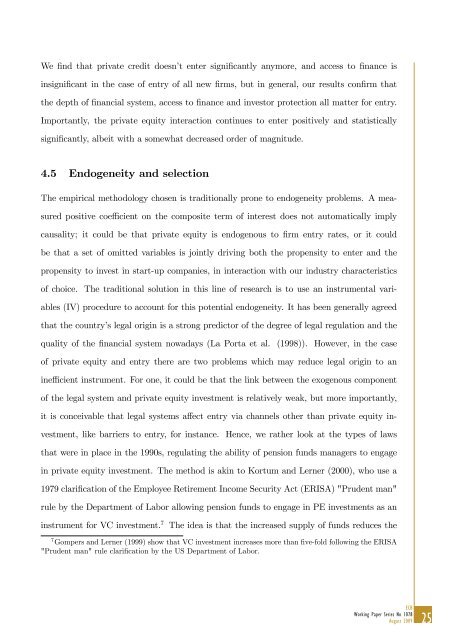On the real effects of private equity investment: evidence from new ...
On the real effects of private equity investment: evidence from new ...
On the real effects of private equity investment: evidence from new ...
- No tags were found...
You also want an ePaper? Increase the reach of your titles
YUMPU automatically turns print PDFs into web optimized ePapers that Google loves.
We …nd that <strong>private</strong> credit doesn’t enter signi…cantly anymore, and access to …nance isinsigni…cant in <strong>the</strong> case <strong>of</strong> entry <strong>of</strong> all <strong>new</strong> …rms, but in general, our results con…rm that<strong>the</strong> depth <strong>of</strong> …nancial system, access to …nance and investor protection all matter for entry.Importantly, <strong>the</strong> <strong>private</strong> <strong>equity</strong> interaction continues to enter positively and statisticallysigni…cantly, albeit with a somewhat decreased order <strong>of</strong> magnitude.4.5 Endogeneity and selectionThe empirical methodology chosen is traditionally prone to endogeneity problems. A measuredpositive coe¢ cient on <strong>the</strong> composite term <strong>of</strong> interest does not automatically implycausality; it could be that <strong>private</strong> <strong>equity</strong> is endogenous to …rm entry rates, or it couldbe that a set <strong>of</strong> omitted variables is jointly driving both <strong>the</strong> propensity to enter and <strong>the</strong>propensity to invest in start-up companies, in interaction with our industry characteristics<strong>of</strong> choice. The traditional solution in this line <strong>of</strong> research is to use an instrumental variables(IV) procedure to account for this potential endogeneity. It has been generally agreedthat <strong>the</strong> country’s legal origin is a strong predictor <strong>of</strong> <strong>the</strong> degree <strong>of</strong> legal regulation and <strong>the</strong>quality <strong>of</strong> <strong>the</strong> …nancial system nowadays (La Porta et al. (1998)). However, in <strong>the</strong> case<strong>of</strong> <strong>private</strong> <strong>equity</strong> and entry <strong>the</strong>re are two problems which may reduce legal origin to anine¢ cient instrument. For one, it could be that <strong>the</strong> link between <strong>the</strong> exogenous component<strong>of</strong> <strong>the</strong> legal system and <strong>private</strong> <strong>equity</strong> <strong>investment</strong> is relatively weak, but more importantly,it is conceivable that legal systems a¤ect entry via channels o<strong>the</strong>r than <strong>private</strong> <strong>equity</strong> <strong>investment</strong>,like barriers to entry, for instance. Hence, we ra<strong>the</strong>r look at <strong>the</strong> types <strong>of</strong> lawsthat were in place in <strong>the</strong> 1990s, regulating <strong>the</strong> ability <strong>of</strong> pension funds managers to engagein <strong>private</strong> <strong>equity</strong> <strong>investment</strong>. The method is akin to Kortum and Lerner (2000), who use a1979 clari…cation <strong>of</strong> <strong>the</strong> Employee Retirement Income Security Act (ERISA) "Prudent man"rule by <strong>the</strong> Department <strong>of</strong> Labor allowing pension funds to engage in PE <strong>investment</strong>s as aninstrument for VC <strong>investment</strong>. 7The idea is that <strong>the</strong> increased supply <strong>of</strong> funds reduces <strong>the</strong>7 Gompers and Lerner (1999) show that VC <strong>investment</strong> increases more than …ve-fold following <strong>the</strong> ERISA"Prudent man" rule clari…cation by <strong>the</strong> US Department <strong>of</strong> Labor.ECBWorking Paper Series No 1078August 200925















